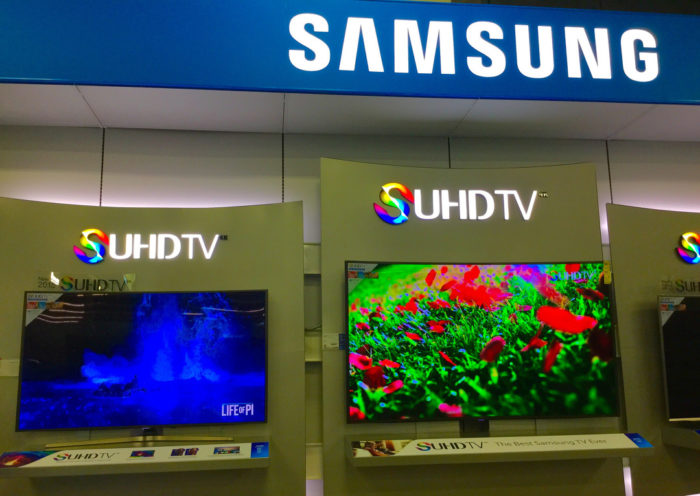
Image Credit: Mike Mozart / CC BY 2.0 / Flickr
Recently manufactured televisions could be using twice as much electricity as shown on government-required EnergyGuide labels as makers exploit a weakness in the Department of Energy’s test procedures, the Natural Resource Defense Council says.
Televisions 32 inches and larger made by Samsung, LG, and Vizio were tested by NRDC and its consultant, Ecos Research, using the DOE method for measuring how much power the sets used, the NRDC said in statement accompanying the report.
“Per our analysis, we believe that the test loop used by DOE does not reflect the characteristics of content people typically watch,” the statement from senior NRDC scientist and lead author Noah Horowitz said. “Samsung and LG appear to be exploiting these anomalies to achieve lower energy use levels during the test than in real-world viewing.”
LG and Samsung, along with Vizio, also have designed their television sets to disable energy-saving features, such as automatic brightness control or motion-detection dimming, whenever users change the main default picture setting on the sets, the NRDC said.
Testing procedures may be perfectly legal. But, the NRDC said, “they smack of bad faith conduct that falls outside the intent of the DOE test method designed to accurately measure TV energy use.”
The study, “The Secret Costs of Manufacturers Exploiting Loopholes in the Government’s TV Test,” said that the characteristics will collectively cost consumers $1.2 billion and add millions of tons of pollutants to the air. The problem will only get worse, the report said, as an “ultra high-definition” video format becomes more widely used.
Manufacturers accused of ‘questionable’ tactics
Energy consumption is measured as the sets play a 10-minute video loop whose content is developed by the International Electrotechnical Commission and meant to include the kind of content that viewers typically see. But, the study says, the loop contains a series of “unusually short scenes that is not representative of most real-world content.” Some manufacturers may have designed their televisions to tailor their energy use in response to the type of imagery the loop uses.
“This would allow a manufacturer to publish very low average power use (and gain a competitive advantage), even though the TV will draw considerably more power when consumers get it home and watch their broadcast and streamed content the way they prefer.”
In addition, Samsung, LG, and Vizio, which collectively represent half of all new sets sold in the U.S., have designed the sets to automatically disable energy-saving features whenever a user changes the main picture setting. The object is to increase the brightness of the screen, which consumers like, but it also disguises the impact on energy use.
“These ‘under the hood’ changes dramatically increase a TV’s energy use and environmental impact, usually without the user’s knowledge. While this may not be illegal, it smacks of bad-faith conduct that falls outside the intent of the DOE test method designed to accurately measure TV energy use,” the study says.
The results of the tests are important in several ways. Television sets with lower energy consumption are more appealing to some consumers, and manufacturers can cite test results when they seek approval to display the government’s Energy Star label. Although there’s no national standard for TV energy efficiency, certain states do have them.
The impact of “a few seemingly innocuous clicks on the remote control” can add up to an extra $10 to $20 per year, or $100 to $200 over the expected 10-year life of the set.
Manufacturers may update software
The NRDC said that it shared the results of its tests with each manufacturer and said “none of them disputed the accuracy of our results or claimed they were limited to a subset of models.” However, the report adds that manufacturers have agreed “to varying degrees” to update software on new television sets so energy-saving features are more likely to stay activated, with LG being the “most responsive” to the organization’s concerns.
The NRDC made a number of recommendations:
- Manufacturers should stop using software that disables energy-saving features on their sets without the consumer’s knowledge.
- The DOE should update its test method so the video test loop is more representative of what people actually watch.
- The Environmental Protection Agency should update Energy Star specs, a process that is apparently underway.
- TV manufacturers should anticipate the wider use of high dynamic range (HDR) programming by incorporating more advanced energy-saving technology.
Weekly Newsletter
Get building science and energy efficiency advice, plus special offers, in your inbox.














2 Comments
VW
Just like the auto manufacturer. Just so I understand what is happening, the DOE rules did not prohibit the manufacturers from putting energy-saving defeating "features" into their software? Quite an omission.
Don't forget LG
Nathan,
As I wrote in my article, Choosing an Energy-Efficient Refrigerator, "When Consumer Reports did their own testing, they found that at least one refrigerator manufacturer, LG, was providing misleading energy-use data. LG rigged one of their refrigerators (model LRFC25750) to turn off a 100-watt electric resistance heater that kept the freezer gasket pliable and frost-free. A relay turned off the heater under only one condition: when the ambient temperature of the room was at 90°F. Not coincidentally, this happens to be the temperature of the test chamber used during EnergyGuide monitoring tests."
Log in or create an account to post a comment.
Sign up Log in